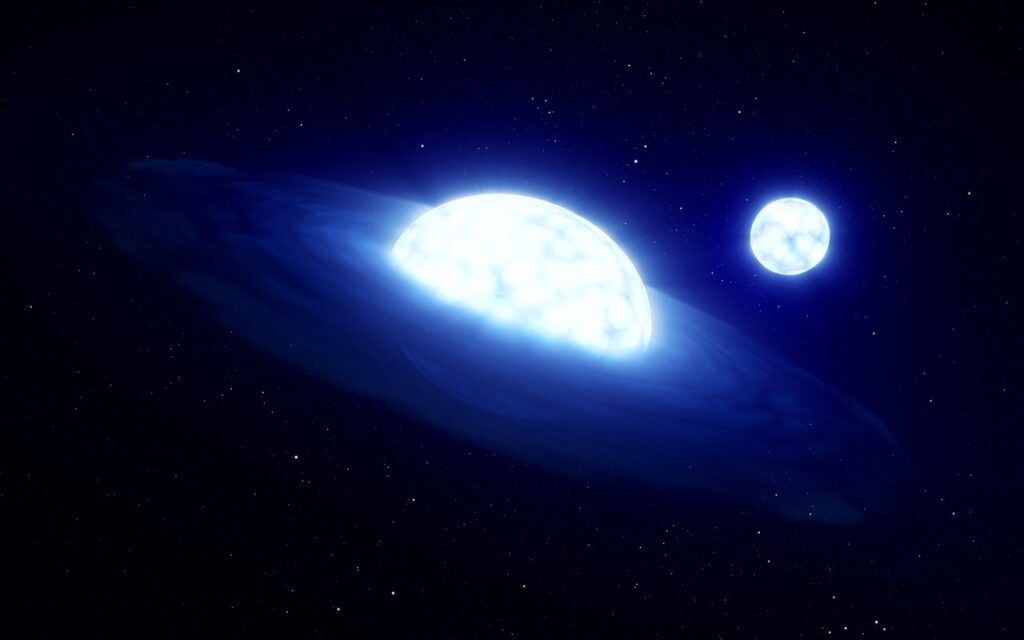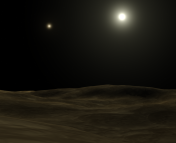Authors: A. J. Frost, J. Bodensteiner, Th. Rivinius, D. Baade, A. Merand, F. Selman, M. Abdul-Masih, G. Banyard, E. Bordier, K. Dsilva, C. Hawcroft, L. Mahy, M. Reggiani, T. Shenar, M. Cabezas, P. Hadrava, M. Heida, R. Klement, H. Sana
First Author’s Institution: Institute of Astronomy, KU Leuven
Status: Published in Astronomy & Astrophysics (closed access), available on ArXiv (https://arxiv.org/abs/2203.01359)

Black holes capture the imagination of astronomers and the public alike. They’re mainstays of music (Soundgarden – Black Hole Sun), film (Christopher Nolan’s 2019 space epic Interstellar), and fiction (Gregory Benford’s Eater (2009)), and the primary targets of some of the largest astronomical collaborations in history (LIGO and EHT). In their more exotic forms, black holes have even been proposed as solutions to some of the open questions in astrophysics, such as dark matter and the nature of the proposed Planet 9.
A Black Hole in our Backyard?
Most black holes, however, are just hanging out in space, minding their own business, until a team comes by to erase them from existence. HR 6819 is a multiple star system only 340 parsecs away in the constellation Telescopium. The star was identified as a multiple system from its spectrum in 2003, and in 2020 a non-accreting black hole was proposed to explain the radial velocity trend. In this hypothesis, a stellar mass black hole and a B3 giant orbit each other in the center of the system, with a distant Be star orbiting the two further out. At the time, and if the hypothesis had been confirmed, this would have been the closest known stellar mass black hole to Earth!
Several teams suggested alternate explanations to explain the observations. Some arguments proposed that the triple architecture would be unstable, or that the proposed black hole was actually *another* tight stellar binary (making this a quadruple system!), but the most prominent alternate explanation is that the system is a simple binary of the B and Be stars on a tighter orbit than originally thought. Although the purported black hole itself is quiescent (that is, not accreting matter from its companion star, and so gives off no light), the actual architecture of the system allows for a relatively simple test to distinguish between the binary and trinary cases.
A Picture That Isn’t There
The radial velocity data indicates that the inner star is orbiting *something* with a period of ~40 days. In order to find out whether this is the black hole candidate or the other star in the system, the authors took high resolution images of HR 6819. Models suggest that in order to confirm the black hole triple, the outer star must be ~100 milliarcseconds away from the inner star. However, if the two stars are separated by ~1 milliarcsecond, the HR 6819 would be a simple binary star system.
Figure 1: The MUSE (left) and GRAVITY (right) images of the HR 6819 system. The clear closely separated binary implies that there is no black hole in HR 6819. Adapted from Fgi. A.1 and Fig. 2 in the paper.
In order to make these observations, the authors used the MUSE and GRAVITY instruments on the European Southern Observatory’s (ESO) Very Large Telescope (VLT). With MUSE, the authors searched for a wide companion, and used GRAVITY to probe very small separations. Ultimately, the lower resolution MUSE data showed a single source, and the high resolution GRAVITY data clearly showed two stars separated by a little over 1 milliarcsecond. With lots of historical radial velocities, the authors also fit the orbit of the binary system in combination with the astrometric data, showing that the observed tight binary is consistent with the 40-day orbital period. However, precise measurements of all the orbital parameters need more than just a single image, leaving the door open for future study of this intriguing system.
Figure 2: The RV trend and astrometric orbit fit for the HR 6819 binary. More astrometry is needed to nail down the precise stellar parameters. Adapted from Fig. 3 in the paper.
Although the nearest stellar black hole candidate vanished without a trace, HR 6819 still provides a fascinating system for study. The stellar binary is likely the result of a recent stellar interaction, where the central B star had a significant amount of its mass stripped away by the companion Be star. If future observations can precisely measure the elemental abundances of the two stars, HR 6819 would be one of the best targets we have to evaluate models of massive binary star system evolution.
Astrobite edited by William Balmer
Featured image credit: ESO/L. Calçada




